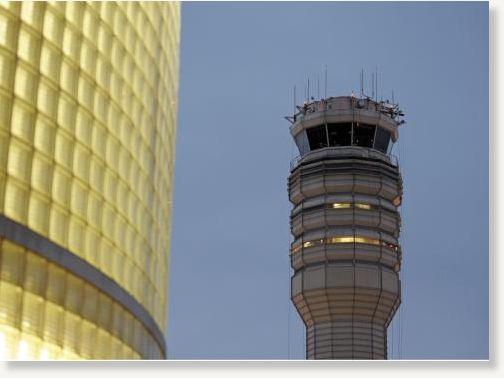
© Clif Owen/APThe FAA control tower at Reagan National Airport is seen in Arlington.
The crisis that has engulfed the nation's air-traffic system deepened Saturday as another air-traffic controller was discovered sleeping on the job, the government announced.
In this case, the controller was working a midnight shift at a crowded facility in Miami. No flights were threatened during the episode, but federal officials also announced they're instituting schedule changes to minimize fatigue among the thousands who work during the wee hours.
In what has become a wave of bad publicity for the nation's aviation system, the Federal Aviation Administration announced Saturday that it had discovered the sixth case of controllers suspected of sleeping on the job this year. None of the incidents has come close to triggering an accident, but the cases have undermined public confidence in the system and prompted widespread criticism.
The unidentified controller works at the Miami Air Route Traffic Control Center, which oversees mostly high-altitude, long-distance flights in a broad swath of the nation's southeastern states. The controller nodded off on the midnight shift and was reported by another controller, the FAA said in a press release. The controller has been suspended.
"According to a preliminary review of air traffic tapes, the controller did not miss any calls from aircraft and there was no operational impact," the aviation agency said.
Since two airline jets landed at Washington Reagan National Airport shortly after midnight on March 23 without clearance because the lone supervisor on duty had fallen asleep, the FAA has revealed five more similar cases. A medical flight carrying a sick patient was forced to land without clearance at Reno/Tahoe International Airport early Wednesday after the tower controller fell asleep.
The FAA announced this week that it would no longer permit controllers to work alone at small and mid-sized airport towers on the midnight shift. The agency has added a second controller at 28 airport towers and one small regional facility.
Unlike most of the previous incidents at airport towers with only one person on duty, there were a total of 12 controllers and two managers on duty at the Miami center at the time of the latest incident, the FAA said.
As a result of the recent spate of incidents, the controllers in Miami had been given a "a briefing on professionalism and the importance of reporting to work fit for duty" prior to the start of the shift, the FAA said.
FAA Administrator Randy Babbitt also announced Saturday that the agency is banning controller schedules that have been linked to fatigue. The schedule changes will go into effect within 72 hours, Babbitt said.
Babbitt did not specify what those changes will be or what schedules would be altered. The FAA said discussions are underway with the controllers' union, the National Air Traffic Controllers Association, and "more details will be released soon."
NATCA President Paul Rinaldi said the union was in "full support" of Babbitt's actions. "We are working closely with the FAA to continue the significant efforts underway to address fatigue and, as the FAA announced today, more details are forthcoming," Rinaldi said in a release.
One common schedule linked to fatigue by the FAA studies is widely known as the "rattler" because it can be so jarring to the system. On this shift, a controller compacts five shifts into four days and on the last day works two shifts in a 24-hour period, making it nearly impossible to get decent sleep.
A joint panel made up of FAA and union officials earlier this year proposed adding to the number of hours off between shifts on this schedule, according to documents obtained by USA TODAY.
However, the scientific studies that led to the suggestion also say that the best way to ensure controllers working during the wee hours are alert is to also give them a chance to nap during regular breaks. So far the FAA has been unwilling to allow controllers or pilots to sleep while on duty and Saturday's FAA release did not mention the possibility of napping.
Sleeping during breaks has been attacked by some lawmakers, including Rep. John Mica, R-Fla., the influential chairman of the House Transportation Committee.
A total of about 3,400 controllers work at least one midnight shift every two weeks, putting them at heightened risk for health problems and safety-critical mistakes, according to the FAA's own research. After several midnight shifts, controllers have the equivalent impairment of someone driving legally drunk, the research says.
Reader Comments
to our Newsletter